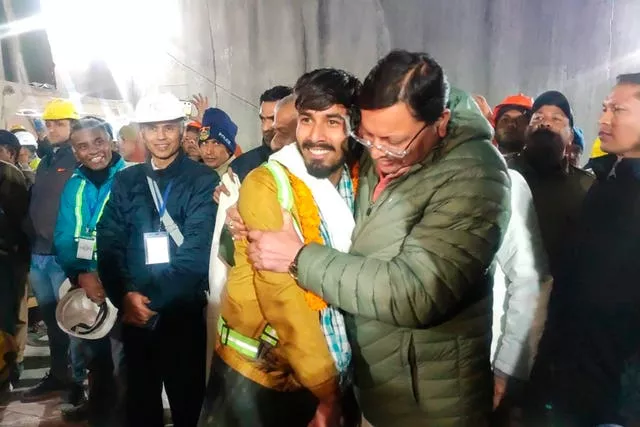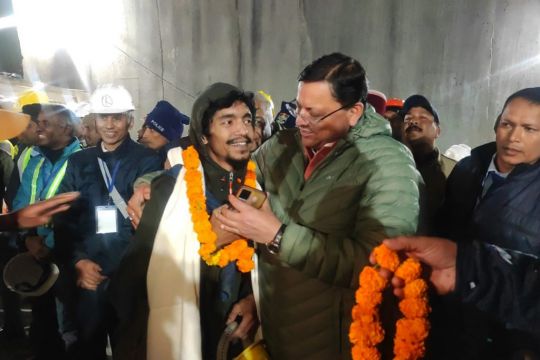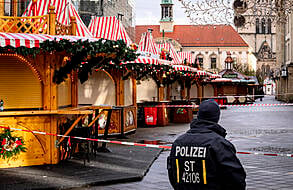All 41 construction workers who were trapped in a collapsed mountain tunnel in northern India for more than two weeks were pulled out on Tuesday, bringing a happy end to a drawn-out rescue mission that had gripped the country for days.
Locals, relatives and government officials erupted in joy, set off firecrackers and shouted “Bharat Mata ki Jai” – Hindi for “Long live mother India” – as smiling workers began emerging from the tunnel entrance.
Officials hung floral garlands around the necks of the first rescued workers as the crowd cheered.
Nitin Gadkari, the country’s minister of road transport and highways, said in a video posted on the social media platform X that he was “completely relieved and happy” after all of the workers were rescued from the Silkyara Tunnel in the northern Indian town of Uttarkashi following the 17-day ordeal.
“This was a well co-ordinated effort by multiple agencies, marking one of the most significant rescue operations in recent years,” Mr Gadkari said.
No-one was seriously injured or killed when the tunnel collapsed early on the morning of November 12.
The workers were finishing their shifts and many were likely to have been looking forward to celebrating Diwali, the festival of lights, that day.
Since early in their ordeal, the workers were provided with food, water and oxygen through pipes, and they emerged healthy, officials said.
They were extracted one by one on a wheeled stretcher that was pulled through a roughly metre-wide tunnel of welded pipes that crews had pushed through the collapsed dirt and rocks.

Before emerging to the cameras and crowds and being whisked away in ambulances, each worker was given a check-up at a makeshift medical camp in the tunnel entrance.
One of the rescuers, Devender, who only gave his first name, told the New Delhi Television channel that “the trapped workers were overjoyed when they spotted us in the tunnel. Some rushed toward me and hugged me”.
The massive rescue mission has grabbed the country’s attention for the past weeks.
The workers got trapped on November 12 when a landslide caused a portion of the 4.5-kilometre (2.8-mile) tunnel they were building in Uttarakhand state to collapse about 200 metres (650ft) from the entrance.

They survived on food and oxygen supplied through narrow steel pipes.
Kirti Panwar, a state government spokesperson, said about a dozen men had worked overnight to manually dig through rocks and debris, taking turns to drill using hand-held drilling tools and clearing out the muck in what he said was the final stretch of the rescue operation.
Rescuers resorted to manual digging after the drilling machine broke down irreparably on Friday while drilling horizontally from the front because of the mountainous terrain of Uttarakhand.
The machine bored through about 47 metres (nearly 154ft) out of approximately the 57-60 metres (nearly 187-196ft) needed, before rescuers started to work by hand to create a passageway to evacuate the trapped workers.
As dusk fell on Tuesday, families of those trapped underground gathered near the site of the accident, anxiously waiting to see their loved ones emerge from the tunnel.

Among them was Jaimal Singh who said he was hopeful he would soon see his brother Gabbar Singh, who was trapped inside.
“Even nature looks cheerful today … the weather is good. Let’s hope this ends soon,” he told the Press Trust of India news agency.
Rescue teams had inserted pipes into dug-out areas and welded them together so the workers could be brought out on wheeled stretchers.
On Sunday, rescuers also began to create a vertical channel with a newly replaced drilling machine as a contingency plan.
What began as a rescue mission expected to take a few days has turned into weeks, and officials have been hesitant to give a timeline for when it might be completed.
“I just feel good. The drilling on top of the mountain is coming along perfectly, in the tunnel, it’s coming along very well. I have never said ‘I feel good’ before,” Arnold Dix, an international tunnelling expert who is helping with the rescue, told reporters at the site earlier on Tuesday.
Most of the trapped workers are migrant labourers from across the country.

Many of their families have travelled to the location, where they have camped out for days to get updates on the rescue effort and in the hopes of seeing their relatives soon.
Authorities have supplied the trapped workers with hot meals through a 6in (15-centimetre) pipe after days of surviving only on dry food sent through a narrower pipe.
They are getting oxygen through a separate pipe, and more than a dozen doctors, including psychiatrists, have been at the site monitoring their health.
The tunnel the workers were building was designed as part of the Chardham all-weather road, which will connect various Hindu pilgrimage sites.
Some experts say the project, a flagship initiative of the federal government, will exacerbate fragile conditions in the upper Himalayas, where several towns are built atop landslide debris.
Large numbers of pilgrims and tourists visit Uttarakhand’s many Hindu temples, with the number increasing over the years because of the continued construction of buildings and roads.







